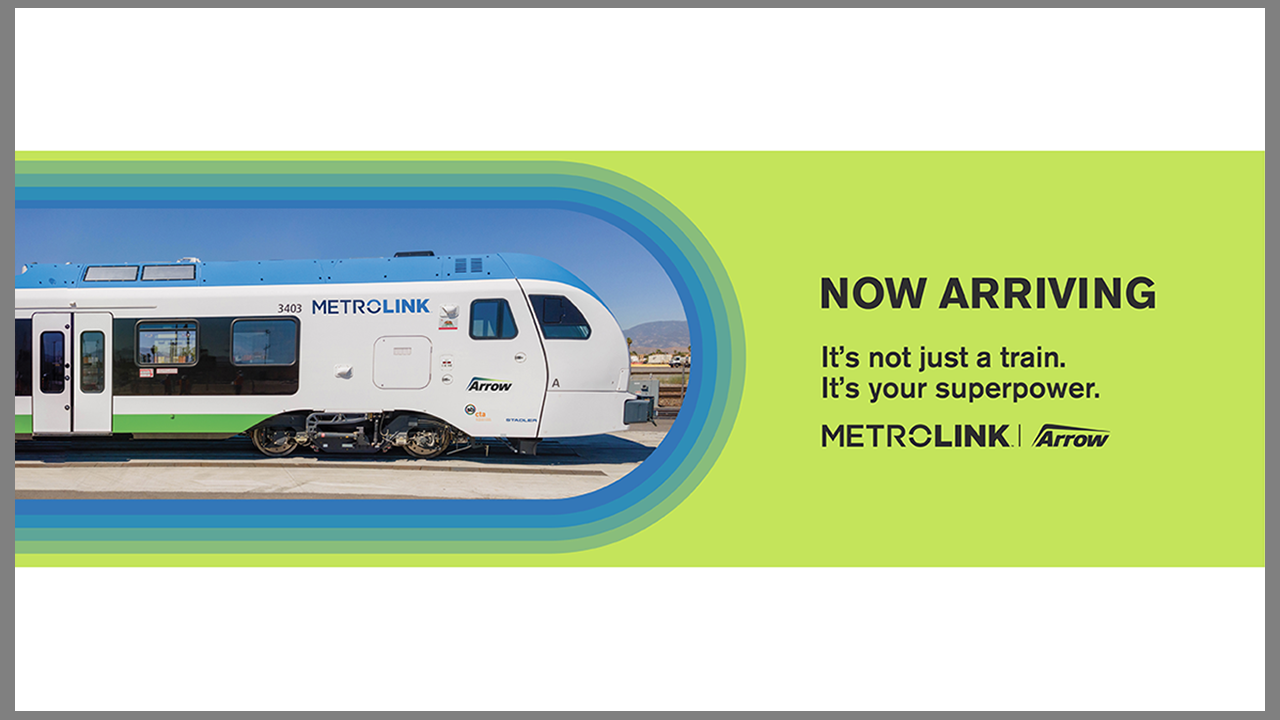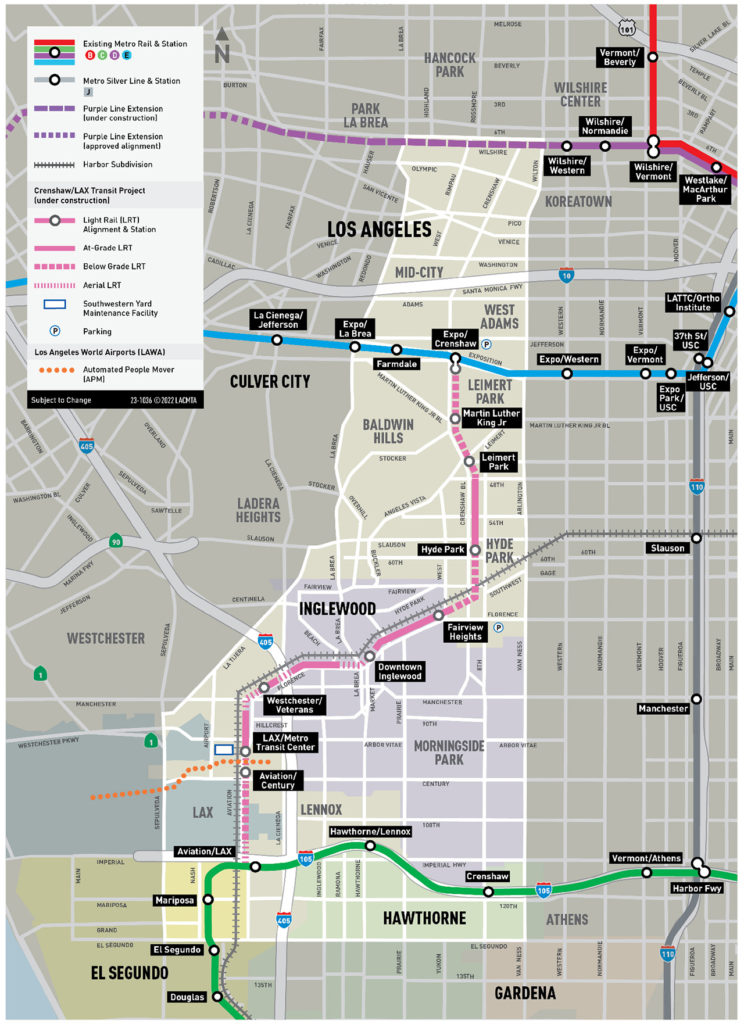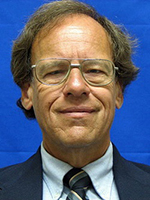
Three New Starts and a Bus Bridge
Written by David Peter Alan, Contributing Editor
The number of new rail transit starts in the United States has slowed in recent years, probably due at least in part to the COVID-19 pandemic. Three years ago, I held the distinction of having ridden every segment of rail transit then operating in the nation. Since that time, there have been twelve new starts or extensions of rail transit lines that have started in service, or that have an opening date scheduled soon.
Six of those new segments are located in California. Three are located in the Bay Area: Sonoma-Marin Area Rail Transit (SMART) between San Rafael and Larkspur, Bay Area Rapid Transit (BART) to Milpitas and Berryesea, and Muni’s new Central Subway for light rail in San Francisco, which opened on Saturday, November 19 for weekend service (weekday service is scheduled to begin on January 7). The other three are located in Southern California: Arrow service between San Bernardino and Redlands, the first segment of the L.A. Metrorail’s Crenshaw Line (K Line) west of downtown, and the northerly extension of the San Diego Trolley’s Blue Line from its original terminal at Old Town.
In an effort to ride some of the new light rail starts before the recent Railway Age/RT&S Light Rail 2022 Conference in Boston, this writer visited the Los Angeles area and San Diego, to ride those three new starts. That trip also entailed using an unusual and temporary means to ride between the two cities: an Amtrak operation involving two distinct rail routes and a bus bridge in-between; the result of concern that some of the track on the Surf Line is unstable, which closed that part of the line while repairs are being made.
The New Arrow Trains
The first, and most interesting, of the new starts is Arrow service between Redlands and the Metrolink station known as Downtown San Bernardino, as distinct from the historic Santa Fe Depot in town, where Amtrak Trains 3 and 4 (the Southwest Chief) stop. The walk between the two took about 25 minutes and, while the station is next to the terminal for local OmniTrax buses and those of other providers, there were none running conveniently at the time. Arrow trains first ran on October 24.
The line was planned and built by the San Bernardino County Transportation Authority and is operated as a component of Metrolink. Arrow operates with self-contained diesel units made by Stadler, similar to the ones that run on Austin’s Capitol MetroRail. The line essentially operates as a shuttle, with two stops in San Bernardino and three in Redlands. There are no other stops. The furthest stop (to the east) is near the campus of Redlands University, while the next stop is in downtown Redlands, at the historic Santa Fe Depot, built in 1910 and now undergoing renovations. The new line is nine miles long.
The station is one of the few truly historic and unaltered buildings in “Historic Downtown Redlands,” generally a misnomer. Still, the downtown area is pedestrian-friendly and active. The A.K. Smiley Library, built in 1898, is an architectural gem and was enlarged in a sympathetic manner. The town features residential neighborhoods that reflect its historic character, a museum about Abraham Lincoln that was founded in 1932, and a museum in a former private house on the other side of town that is now full of historic decorative glassware (a long walk from downtown and open only on weekend afternoons).
Despite the DMU equipment and the name “Arrow” with its own logo, the service is operated as a part of Metrolink, using Metrolink’s fare structure and with schedules included in Metrolink timetables. Service runs much more frequently between Redlands and San Bernardino than between San Bernardino and Los Angeles, although service on the San Bernardino Line is the most-frequent of any in the pre-existing Metrolink system. For example, there are only eight trains in each direction on the Los Angeles side of San Bernardino on weekends, but fourteen on the Redlands side. Will a Redlands shuttle without a connection to the City of Angels garner significant ridership? Time will tell.
There is also limited service between San Bernardino and Orange County on the Inland Empire – Orange County Line, but not all trains on it have a Redlands connection. Neither do they go as far as Oceanside at this writing, because some of the track between San Clemente and Oceanside is out of service while repairs to stabilize it continue. I will have more on that situation later in this article.
At this writing, trains scheduled to run at the beginning and end of the service day are not operating to avoid sounding train horns at those hours, and until a quiet zone can be implemented. Plans also call for a unit powered by hydrogen fuel cells to be used on the line in 2024, the first such use in this country.
A number of Metrolink trains with their bi-level and multilevel consists came through Redlands during my visit, apparently to familiarize Metrolink crews with the line into town. The schedule calls for only one round trip with a Metrolink consist on weekdays; the through-running Arrow Express, the fastest commuter train on the line and the only one that does not require a change at San Bernardino. It leaves Redlands at 5:58 a.m. and arrives at L.A. Union Station at 7:29 a.m.. Returning, it leaves Union Station at 5:26 p.m. and arrives in Downtown Redlands at 7:03 p.m. That running time of 97 minutes compares favorably to that for the next train, which leaves Union Station at 5:37 p.m., requires a change (with a nine-minute transfer time at San Bernardino Downtown), and is scheduled to arrive at Redlands Downtown at 7:52 p.m.; a running time of 135 minutes. The faster Arrow Express train uses a separate platform at Redlands from other trains, which require transfer times ranging from nine to fourteen minutes.
New Los Angeles LRT

Service on the long-awaited Crenshaw Line (K Line) of the Metrorail system began on October 7, after eight years of construction. The current line is the first operable segment, and it connects with the Expo Line (E Line) at the Exposition/Crenshaw stop on the current at-grade light rail line. The new line is also a light rail line, and the connection from the Expo Line requires a transfer to an underground station at its current northern terminus. During the 18-minute ride, the line takes riders through a deep-bore tunnel, on an exclusive right-of-way along Crenshaw Boulevard, through a cut-and-cover tunnel, on a partially-elevated viaduct, and in a trench. The line goes through the City of Inglewood, and ends in the Westchester neighborhood.
Although the line only connects with the Expo Line now, there are plans to extend it northward to Wilshire Boulevard, where it will connect with the Purple Line (D) subway, and toward the airport, with a connection to the Green Line (C) and the LAX Automated People Mover. Service to the airport is expected to begin in 2024.
San Diego Blue Line Stretch
Despite its name, the San Diego Trolley system operates with articulated three-car units with pantographs. It claims the distinction of being the first purpose-built light rail system in the United States, following the introduction of such lines in Edmonton and Calgary, Alberta, in Canada.
With its three main lines (color-coded Blue, Orange, and Green) and the Silver Line, a downtown circulator that runs with historic PCC cars during the day on weekends, the system is still growing. Its latest addition is a northward extension from Old Town to the UTC Center, a new development of high-rise buildings that feature retail and residential uses. The extension, also known as the Mid-Coast Corridor Transit Project, runs 10.9 miles and opened for service on November 21, 2021. Part of the extension runs along the water, alongside the historic Santa Fe Surf Line, which is also used by Coaster trains to Oceanside and Amtrak Pacific Surfliner trains to Los Angeles and points north under normal operation, which is suspended at this writing. It includes nine new stations and runs through Moreno, Bay Park, La Jolla and University City, and serves the University of California at San Diego (UCSD). The entire Blue Line, from UTC to San Ysidro on the Mexican border, is now 26.3 miles long.
The line connects with Coaster and Pacific Surfliner trains at Old Town, and the historic station there is now a souvenir and snack shop. Across the street is the Old Town State Historic Park; a collection of old San Diego buildings now housing museums, shops, and some eateries where the city got its start.
Getting to San Diego a Challenge
At this writing, going between Los Angeles or points north, and San Diego, is more difficult than usual. That applies to some intermediate stops, too. The problem arose on September 29, when it was announced that Amtrak and Metrolink service would be suspended between Laguna Niguel/Mission Viejo (Metrolink trains) or Irvine (Amtrak trains) and Oceanside, effective September 30, due to safety concerns over instability of the track at San Clemente, where the line runs along the beach.
On October 5, Kevin Smith, Editor-in-Chief of International Railway Journal (IRJ) reported for Railway Age about the outage (at https://www.railwayage.com/passenger/irvine-san-diego-main-line-closed-%EF%BF%BCuntil-further-notice%EF%BF%BC/?RAchannel=home). Smith began his report by saying: “Amtrak and Metrolink on Sept. 30 suspended operation of passenger services between Irvine and San Diego, due to safety concerns with the railway infrastructure in San Clemente following heavy rains from Tropical Storm Kay” and continued: “According to the Los-Angeles – San Diego – San Luis Obispo (LOSSAN) Rail Corridor Agency, which manages the Amtrak Pacific Surfliner service on the route, consultations with geologists, geotechnical engineers and surveyors revealed that there might be safety concerns with a section of track in the San Clemente area. The LOSSAN agency decided to immediately stop operation on the route.” Smith also reported that the Orange County Transportation Authority (OCTA), which owns the affected section of track, had started emergency repairs. Although Smith had reported hopes that the line would be back in service in November, the current estimate is that construction will be completed in February.
The Metrolink website gave a summary of the events surrounding the closure since that time as a “service update” concerning the Orange County and Orange County / Inland Empire Lines. On Friday, October 7, Metrolink reported: “Amtrak Pacific Surfliner announced today that the Rail 2 Rail program with Metrolink is temporarily suspended between Oceanside and Irvine due to the track closure south of the Laguna Niguel/Mission Viejo Station. Amtrak buses operating between Oceanside and Irvine have limited capacity, so an Amtrak reservation is required.” Metrolink has not provided a bus bridge to connect its own trains, even though service between Laguna Niguel and Oceanside is limited, claiming a shortage of bus drivers.
On Friday, October 14, the site reported: “According to OCTA officials, restoration of passenger rail service could happen in as soon as 60 days, in mid-December, or when the construction is expected to finish in mid-January, in 90 days,” information that is now outdated. The next report came on Thursday, October 20, with the news that weekend service to San Juan Capistrano, San Clemente, and San Clemente Pier (served by Metrolink only on weekends) would resume on Saturday, October 29. There are no intermediate stops between San Clemente Pier and Oceanside, but Metrolink did not explain where a bus bridge was not provided between those stops for the four weekend round trips to and from Los Angeles and the two round trips to and from San Bernardino. The most recent report on the site was dated November 15 and announced that construction will not be completed until February.
Two Trains and a Bus
Buses between Los Angeles and San Diego have not been affected, but the only rail access is on a reduced Amtrak schedule. Amtrak is issuing tickets between Los Angeles and San Diego in three segments: rail segments between Los Angeles and Irvine and between Oceanside and San Diego, with a bus bridge between Irvine and Oceanside. That service runs on a reduced schedule, with five trips in each direction, seven days a week. The trip takes longer than when trains ran through, with running times between the Santa Fe Depot in San Diego and Los Union Station ranging from 3:03 to 3:54. Some of those trains extend north of Los Angeles, to Santa Barbara or San Luis Obispo.
Amtrak does not show a release on the service change in the “Media Center” section of its website. The only mention is in a “Passenger Advisory” dated November 22, which bears the headline Pacific Surfliner All Reserved for Thanksgiving Holiday. It concentrated on the announcement that all seats on the trains on the line must be reserved from Wednesday, November 23 through Monday, November 28. Only the fourth paragraph mentioned the service change, saying: “Please keep in mind that the tracks remain closed in San Clemente due to stabilization work along the right-of-way. When traveling too-from San Diego County, a bus connection is required between Oceanside and Irvine. Connections are guaranteed. Limited service is operating to/from San Juan Capistrano.”
California: No New Start Monopoly
While a majority of new starts during the past three years are running in California, there are some in other places, too. In neighboring Arizona, the Tempe Streetcar opened for service on May 20, 2022. The three-mile line serves downtown Tempe and Arizona State University, and connects with the main light rail line operated by Valley Metro.
The CityLynx Gold Line in Charlotte, North Carolina expanded 2.5 miles on August 30, 2021 from its original 2015 length. It was previously a short streetcar line on Trade Street.
The Silver Line on Washington, D.C. area’s Metro Rail now goes to Dulles Airport and beyond, through Herndon, to a new western terminus at Ashburn. The new extension, Phase 2 of the line, which runs from the former terminus in Reston, opened on November 15. It is 11.5 miles long; slightly shorter than the 11.7-mile Phase 1 between Reston and the point where it diverges from the Orange Line.
North of Boston, part of the Green Line Extension (GLX) on the MBTA’s light rail system is running. Some of the attendees at the recent Light Rail 2022 conference in Boston had an opportunity to ride on the one-stop Union Square Branch from the relocated Lechmere Station to the branch’s namesake station in Somerville. The 0.7-mile segment west of Red Bridge Junction opened on March 21, 2022. At this writing, testing is occurring on the five-station Medford Branch, running 3.0 miles west of Red Bridge Junction to a terminal near Tufts University. It is scheduled to open for service on December 12.
Last, but not least, there is the deep-cavern terminal that New Yorkers have been anticipating for years: “East Side Access” far below Metro North’s Grand Central Terminal, for the Long Island Rail Road (LIRR). The railroad calls it “Grand Central Madison” after neighboring Madison Avenue. Service is expected to begin in December, which would give riders access to the East Side, as well as the West Side at Penn Station. Most of the current through service to and from the Atlantic Avenue terminal in Brooklyn will disappear, and most of the trains serving that facility will be shuttles to Jamaica.

David Peter Alan is one of America’s most experienced transit users and advocates, having ridden every rail transit line in the U.S., and most Canadian systems. He has also ridden the entire Amtrak network and most of the routes on VIA Rail. His advocacy on the national scene focuses on the Rail Users’ Network (RUN), where he has been a Board member since 2005. Locally in New Jersey, he served as Chair of the Lackawanna Coalition for 21 years, and remains a member. He is also a member of NJ Transit’s Senior Citizens and Disabled Residents Transportation Advisory Committee (SCDRTAC). When not writing or traveling, he practices law in the fields of Intellectual Property (Patents, Trademarks and Copyright) and business law. The opinions expressed here are his own.


